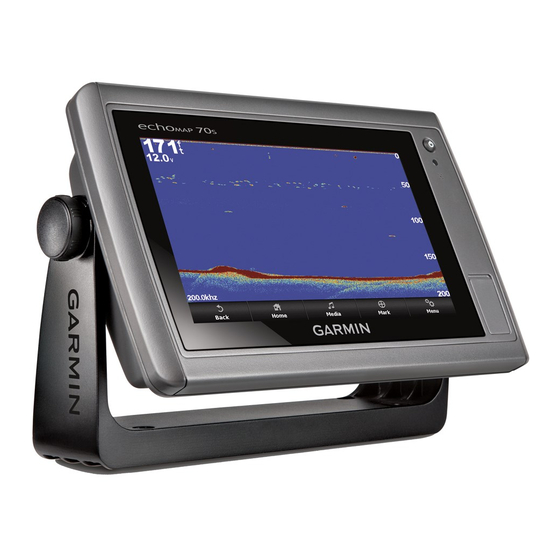- ページ 42
船舶用GPSシステム Garmin echomap 50 seriesのPDF オーナーズマニュアルをオンラインで閲覧またはダウンロードできます。Garmin echomap 50 series 50 ページ。 Flat-mount kit
Garmin echomap 50 series にも: クイック・スタート・マニュアル (4 ページ), オーナーズマニュアル (38 ページ), オーナーズマニュアル (44 ページ), オーナーズマニュアル (30 ページ), 取付説明書 (6 ページ), 取付説明書 (6 ページ), 取付説明書 (34 ページ)

NMEA 0183 Settings
Select Settings > Communications > NMEA 0183 Setup.
Sounder: Enables NMEA 0183 output sentences for the
sounder (if applicable).
Route: Enables NMEA 0183 output sentences for routes.
System: Enables NMEA 0183 output sentences for system
information.
Garmin: Enables NMEA 0183 output sentences for Garmin
proprietary sentences.
Posn Precision: Adjusts the number of digits to the right of the
decimal point for transmission of NMEA output.
Waypoint IDs: Sets the device to transmit waypoint names or
numbers via NMEA 0183 while navigating. Using numbers
may resolve compatibility issues with older NMEA 0183
autopilots.
Diagnostics: Displays NMEA 0183 diagnostic information.
Defaults: Restores the NMEA 0183 settings to the original
factory defaults.
NMEA 2000 Settings
Select Settings > Communications > NMEA 2000 Setup.
Device List: Displays the devices connected to the network.
Label Devices: Changes the labels for available connected
devices.
Viewing a List of NMEA 2000 Network Devices
You can view the devices connected to the NMEA 2000
network.
Select Settings > Communications > NMEA 2000 Setup >
Device List.
Setting Alarms
Navigation Alarms
Select Settings > Alarms > Navigation.
Arrival: Sets an alarm to sound when you are within a specified
distance or time from a turn or a destination.
Anchor Drag: Sets an alarm to sound when you exceed a
specified drift distance while anchored.
Off Course: Sets an alarm to sound when you are off course by
a specified distance.
System Alarms
Alarm Clock: Sets an alarm clock.
Device Voltage: Sets an alarm to sound when the battery
reaches a specified low voltage.
GPS Accuracy: Sets an alarm to sound when the GPS location
accuracy falls outside the user-defined value.
Setting the Fuel Alarm
Before you can set a fuel level alarm, a compatible fuel flow
sensor must be connected to the NMEA 2000 network.
You can set an alarm to sound when the total amount of
remaining onboard fuel reaches the level you specify.
1
Select Settings > Alarms > Fuel > Fuel Alarm > On.
2
Enter the remaining amount of fuel that triggers the alarm.
Setting Weather Alarms
Before you can set weather alarms, you must have a compatible
chartplotter connected to a weather device, such as a GXM
device, and have a valid weather subscription.
1
Select Settings > Alarms > Weather.
2
Turn on alarms for specific weather events.
Units Settings
Select Settings > Units.
36
System Units: Sets the unit format for the device.
Variance: Sets the magnetic declination, the angle between
magnetic north and true north, for your present location.
North Reference: Sets the direction references used in
calculating heading information. True sets geographic north
as the north reference. Grid sets grid north as the north
reference (000º). Magnetic sets the magnetic north as the
north reference.
Position Format: Sets the position format in which a given
location reading appears. Do not change this setting unless
you are using a map or chart that specifies a different
position format.
Map Datum: Sets the coordinate system on which the map is
structured. Do not change this setting unless you are using a
map or chart that specifies a different map datum.
Pressure Ref. Time: Sets the reference time used to calculate
the barometer trend. The trend is indicated in the barometer
field.
Time Format: Sets a 12-hour, 24-hour, or UTC time format.
Time Zone: Sets the time zone, or allows automatic selection
based on GPS location.
Navigation Settings
NOTE: Some settings and options require additional charts or
hardware.
Select Settings > Navigation.
Route Labels: Sets the type of labels shown with route turns on
the map.
Auto Guidance: Sets the parameters the chartplotter uses
when calculating an Auto Guidance path, when you are using
some premium maps.
Turn Transition Activ.: Sets the turn transition to be calculated
based on time or distance.
Turn Transition Time: Sets how many minutes before the turn
that you transition to it as the next leg, when Time is selected
for the Turn Transition Activ. setting. You can raise this value
to help improve the accuracy of the autopilot when navigating
a route or an Auto Guidance path with many frequent turns or
at higher speeds. For straighter routes or slower speeds,
lowering this value can improve autopilot accuracy.
Turn Transition Dist.: Sets how far before the turn that you
transition to it as the next leg, when Distance is selected for
the Turn Transition Activ. setting. You can raise this value to
help improve the accuracy of the autopilot when navigating a
route or an Auto Guidance path with many frequent turns or
at higher speeds. For straighter routes or slower speeds,
lowering this value can improve autopilot accuracy.
Route Start: Selects a starting point for route navigation.
Auto Guidance Path Configurations
The Preferred Depth and Vertical Clearance settings influence
how the chartplotter calculates an Auto Guidance path. If an
area has an unknown water depth or an unknown obstacle
height, the Auto Guidance path is not calculated in that area. If
an area at the beginning or the end of an Auto Guidance path is
shallower than the Preferred Depth or lower than the Vertical
Clearance settings, the Auto Guidance path may not be
calculated in that area, depending on the map data. On the
chart, the course through those areas appears as a gray line or
a magenta and gray striped line. When your boat enters one of
those areas, a warning message appears.
NOTE: Auto Guidance is available with premium charts, in some
areas.
NOTE: Not all settings apply to all maps.
CAUTION
Device Configuration
